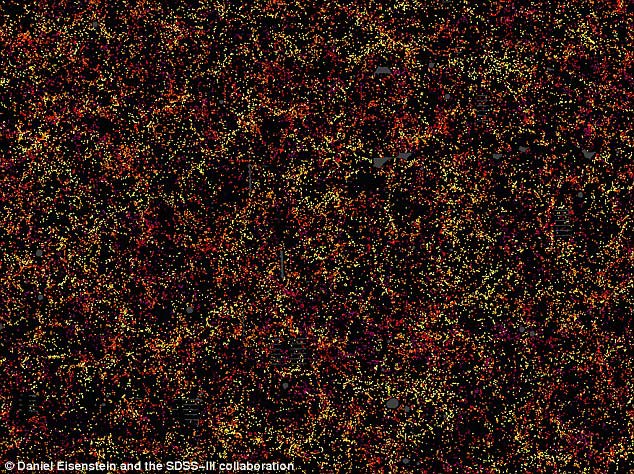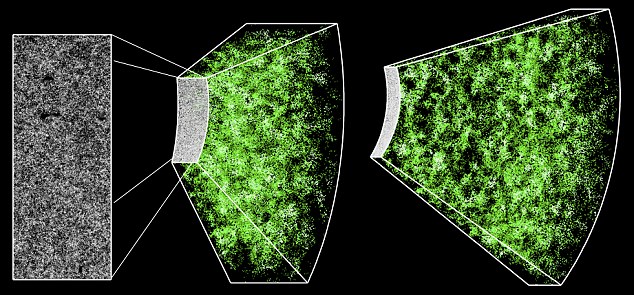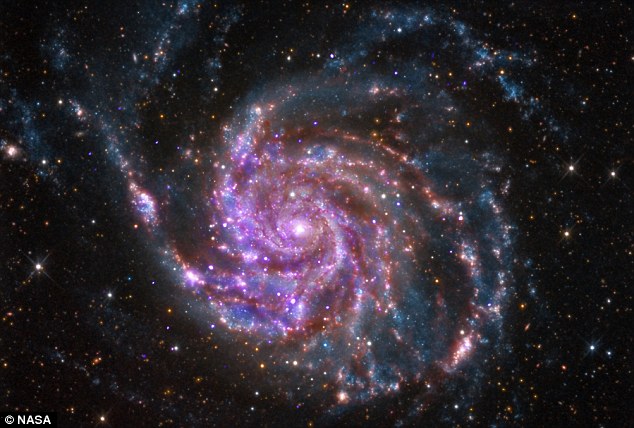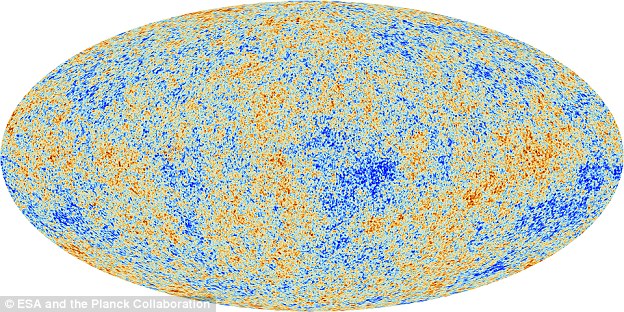

It might look more like a Jackson Pollock painting, but scientists have constructed the largest ever 3D map of the universe showing more than a million galaxies up to 6 billion light years away.
The map helps to reveal the scale of our vast universe, which is thought to contain more than one hundred billion galaxies.
It has already allowed researchers to make one of the most precise measurements yet of Dark Energy - the mysterious force that is causing the universe to expand at an accelerating rate.

Each dot in this picture indicates the position of a galaxy 6 billion years into the past. The image covers about 1/20th of the sky, a slice of the universe 6 billion light-years wide, 4.5 billion light-years high, and 500 million light-years thick.
An international team of astronomers, co-led by Dr Rita Tojeiro from the University of St Andrews, produced the map using data from the Sloan Digital Sky Survey III (SDSS-III).
The team mapped a volume of 650 cubic billion light years, including galaxies that are more than 6 billion light years away.
'Over the last decade we have prepared and conducted the largest survey of the Universe yet,' said Dr Tojeiro.
'By measuring the positions of 1.2 million galaxies over one quarter of the sky, we mapped the three-dimensional structure of the Universe over a volume of 650 cubic billion light years.
The map has been used to make one of the most precise measurements yet of the dark energy currently driving the accelerated expansion of the universe.
'Using this map we were able to make some of crispest measurements yet of how dark energy is driving the expansion of the universe.'

This is a section of the three-dimensional map. The rectangle on the far left shows a cut-out of an area in the sky containing nearly 120,000 galaxies, or roughly 10 per cent of the total survey. Every dot in the cut-out transforms the two-dimensional picture into a three-dimensional map, extending the view out to 7 billion years in the past.
Dark energy is a phrase used by physicists to describe a mysterious 'something' that is causing the accelerated expansion of the universe.
Dark matter is thought to be the gravitational 'glue' that holds the galaxies together, since just five per cent of the universe is made of known material such as atoms and subatomic particles.
Shaped by a continuous tug-of-war between dark matter and dark energy, the map allows astronomers to measure the expansion rate of the universe and thus determine the amount of matter and dark energy that make up the present-day universe.
Hundreds of scientists from the Sloan Digital Sky Survey III (SDSS-III) collaborated to make the map.
A collection of papers describing these results was submitted this week to the Monthly Notices of the Royal Astronomical Society.

When physicists study the dynamics of galaxies (pictured) and the movement of stars, they are confronted with a mystery. If they only take visible matter into account, their equations simply don't add up: the elements that can be observed are not sufficient to explain the rotation of objects and the forces.
Although the volume surveyed was huge, it constitutes only a tiny proportion of the entire universe.
'If we were to scale the volume of our survey to a cube 1 mile on each side, then the visible part of an individual galaxy would be about 1 millimetre across,' Dr Tojeiro said.
'Our challenge in the analysis of this map was equivalent to measuring the distances between all the pairs of galaxies separated by 100 yards throughout a cubic mile of space!'
Dr Florian Beutler from the University of Portsmouth, who led two of the papers submitted this week, said: 'If dark energy has been driving the expansion of the universe over that time, our map tells us that it is evolving very slowly if at all: the change is at most 20 per cent over the past 7 billion years.'
The map also reveals the distinctive signature of the coherent movement of galaxies toward regions of the universe with more matter, due to the attractive force of gravity.
Much of what scientists know about the relative contributions of dark matter and dark energy comes from the relic radiation left behind from the Big Bang, called the cosmic microwave background (CMB).

Looking at the CMB, scientists have found temperature fluctuations, or anisotropies. The most complete survey of the CMB was completed by Esa using the Planck space telescope in March 2013 (pictured) and we are starting to reach a point where we have almost mapped all of the anisotropies, according to a new paper.
The cosmic microwave background is the thermal radiation left over from the time of 'recombination' in Big Bang cosmology.
Dark energy had been previously determined to significantly influence the expansion of the universe starting about 5 billion years ago.
But the new survey measured it from before this point, 7 billion years ago, out to near the present day, 2 billion years ago.
'We see a dramatic connection between the sound wave imprints seen in the cosmic microwave background 400,000 years after the Big Bang to the clustering of galaxies 7-12 billion years later, said Dr Tojeiro.
'The ability to observe a single well-modelled physical effect from recombination until today is a great boon for cosmology.'
The observed amount of infall is explained well by the predictions of general relativity.
This agreement supports the idea the acceleration of the expansion rate is driven by a phenomenon at the largest cosmic scales, such as dark energy, rather than a breakdown of our gravitational theory.
Day|Week

 Thai most beautiful transgender Nong Poy release new photos
Thai most beautiful transgender Nong Poy release new photos Top 10 livable Chinese cities
Top 10 livable Chinese cities The last primitive tribe in China
The last primitive tribe in China China's first intelligent security robot debuts in Chongqing
China's first intelligent security robot debuts in Chongqing A Total of 3,552 Subscribers Vanish In Two Days; YouTube Closes All Doors to Users’ Inquiries
A Total of 3,552 Subscribers Vanish In Two Days; YouTube Closes All Doors to Users’ Inquiries Out of this world! Futuristic UFO-shaped yacht has its own garden and a stunning underwater viewing deck
Out of this world! Futuristic UFO-shaped yacht has its own garden and a stunning underwater viewing deck An old tea house in Chengdu
An old tea house in Chengdu Furious Customer Crushes All the Buns from Vendor Just Because He Was Given the Wrong Flavor
Furious Customer Crushes All the Buns from Vendor Just Because He Was Given the Wrong Flavor 20 post-90s couples hold ’naked marriage‘ in E. China
20 post-90s couples hold ’naked marriage‘ in E. China Female official wearing traditional Han costume to promote local tourism
Female official wearing traditional Han costume to promote local tourism